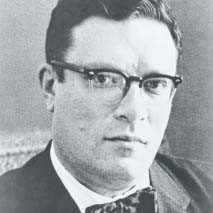By publishing his three Laws of Robotics in 1942, Isaac Asimov defined rules for humans and robots to coexist which are more relevant today than ever before. The author and scientist, who died in 1992, didn’t just inspire the science-fiction community with his stories, but robotics developers as well.
Speedy no longer knows what to do. The nimble robot has been sent to gather the urgently required raw material selenium on the planet Mercury, yet this entails huge risks to his very existence. On the other hand, he wants to obey orders given to him by humans. The conflict between the laws governing his behaviour is just too much to take, causing Speedy to go haywire. He recites Gilbert and Sullivan and drives around and around in circles. Only when his human handler risks his life in front of Speedy’s eyes can the robot’s electronic brain think clearly again: after all, Speedy must obey the First Law at all costs.
- A robot may not injure a human being or, through inaction, allow a human being to come to harm.
- A robot must obey orders given to it by human beings except where such orders would conflict with the First Law.
- A robot must protect its own existence as long as such protection does not conflict with the First or Second Laws.
Ethical questions are becoming relevant today
Isaac Asimov cemented his place in history with this scene from his short story “Runaround”, published in 1942. Over the years that followed, numerous authors and film-makers took inspiration from the Laws of Robotics laid down for the first time in the short story and used them as a basis for creating their own works of fiction. Asimov’s ideas are not purely the stuff of fiction, but attracted a great deal of interest from researchers from the fields of Robotics and Artificial Intelligence – and continue to do so. Even today, the Three Laws serve as a fundamental code of practice for developers when programming their robots. “With the impending arrival of the first autonomous robots in the midst of our society, certain ethical questions that science-fiction author Isaac Asimov first formulated as his famous Laws of Robotics in 1942 will become very relevant – for example, whether a robot may kill or injure humans,” says Philipp Schaumann from website Sicherheitskultur.at. He also gave a lecture on the topic of “Ethics for autonomous vehicles” at the IT-Security Community Xchange symposium in late 2016.
From biochemist to author
Yet it wasn’t just the relationship between humans and robots that occupied Asimov, who was born on 2 January 1920 in Petrovichi, Russia. Among his bibliography of over 500 books, there are numerous scientific works on physics, chemistry and other natural sciences, yet also books on the Bible, William Shakespeare or Greek and Roman history. Asimov was a scientist by vocation, after all. After emigrating to the USA with his family at the age of three and growing up in Brooklyn, he studied chemistry at Columbia University and gained his Doctorate in Biochemistry in 1949. The scientist first came into contact with the American science-fiction scene while it was still in its infancy during his studies. He published his first short story in 1939, yet only became a full-time author in 1958, giving up his position as a lecturer at Boston University in order to dedicate himself fully to his writing.
Spotlight on the conflict between technology and ethics
The “Foundation” trilogy was one of Asimov’s most successful works. In this science-fiction series played out on a galactic scale, Asimov tells how a scientist succeeds in predicting and guiding the development of humanity for millennia using so-called “psychohistorics”. Asimov combined this trilogy with his many robotics and Galactic Empire novels to form a comprehensive series about the emergence of a new civilisation in outer space.
The conflict between technology and ethics is one theme which is common to all of his novels and short stories. It wasn’t just Asimov’s preoccupation with futuristic technology that came to the fore in his stories about robots, but also the effects of this technology on human society – and the dilemmas that this might bring about.
EU Parliament demands legislation on robots
A press statement from the European Parliament released at the start of 2017 shows just how far ahead of his time Asimov really was. In it, delegates call on the EU Commission to submit legislation concerning robotics and artificial intelligence. “One option might be to assign robots the status of ‘electronic persons’, at least as far as compensation for damage is concerned,” reported Mady Delvaux in Luxembourg. It was she who formulated the report in question and submitted it to the Commission. The EU Parliament delegates propose that researchers and designers should have a voluntary ethical code of conduct for robotics in order to ensure that their actions comply with legal and ethical standards and that the design and use of robots respect human dignity.
Asimov foresaw this ambivalence between ethics and robotics: in his fictitious version of 2015, robots are indispensable helpers in the conquest of distant planets. On Earth, however, they are forbidden due to people’s fear of them.
(Picture Credis: United States Library of Congress; Unsplash: NASA)



